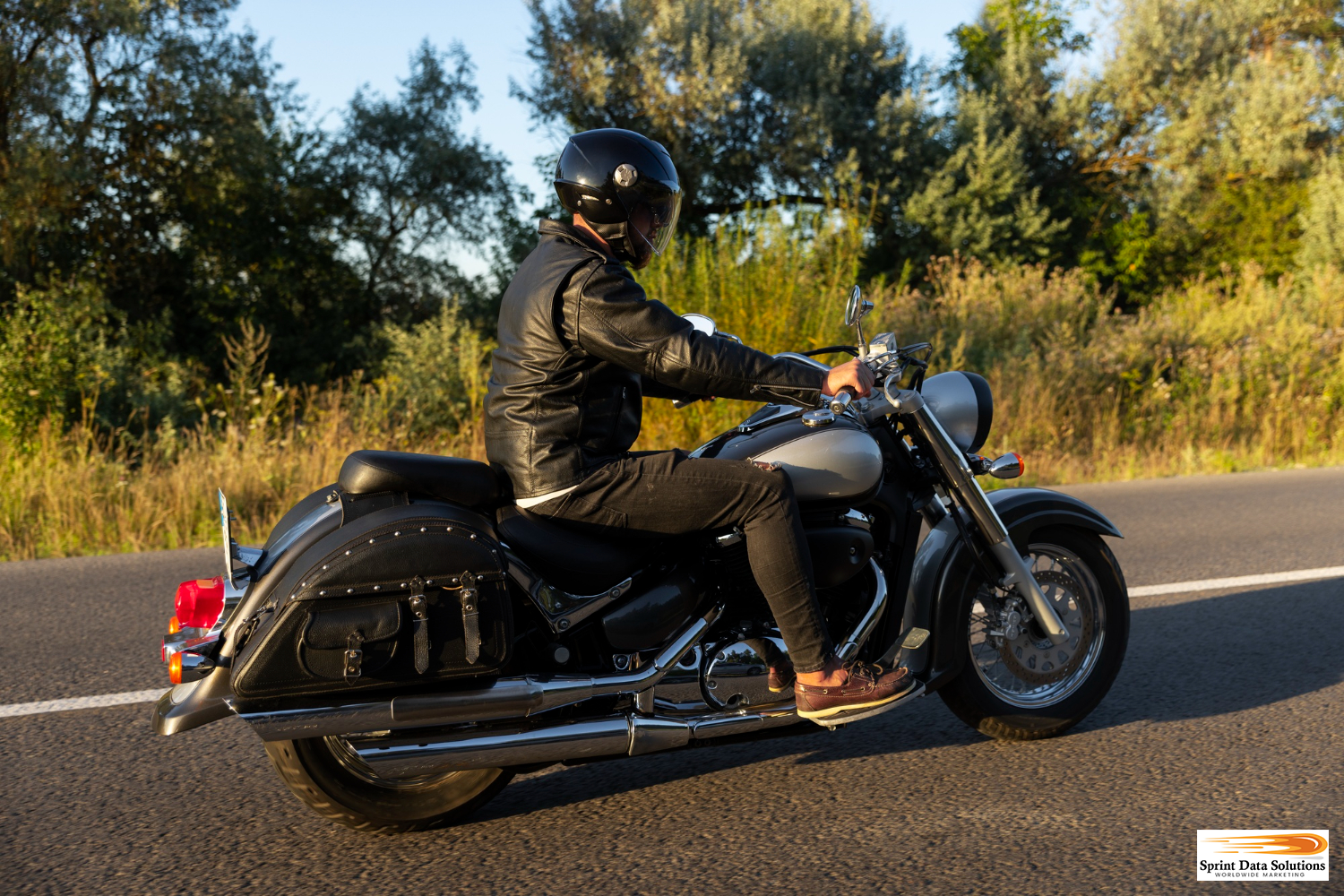Trike Owners Are A New & Growing Market
America, with its relatively young history, has had the unique opportunity to develop and modernize in ways that many older nations could not. One of the clearest examples of this progress is the vast and intricate network of streets, roads, and highways that spans the nation. Over the decades, these thoroughfares have enabled not only daily commutes but also cross-country travel, allowing Americans the freedom to explore their country by car or truck. This development of infrastructure has been instrumental in shaping the American experience, with motor vehicle travel becoming an integral part of the nation’s identity.
At the heart of this transportation revolution lies the motorcycle—a symbol of personal freedom and adventure. For generations, motorcycles have been a quintessential part of American culture, embodying a spirit of independence and the thrill of the open road. However, as the world continues to evolve, so too does the way people enjoy their journeys. Enter the trike motorcycle—an innovation that blends the thrill and excitement of traditional motorcycling with greater stability and comfort. For many riders, the trike provides a safer and more accessible option, especially for those seeking the same freedom of the road but with a bit more security.
This rise in the popularity of trike motorcycles presents a new and rapidly growing market, one that brings with it a fresh set of customers with distinct needs and preferences. The emergence of the trike not only expands the variety of vehicles people use for leisure and travel but also opens up new opportunities for businesses to cater to these customers with specialized products, services, and support. Sprint Data Solutions Worldwide Marketing recognizes this shift and has proactively positioned itself to assist businesses in reaching this burgeoning demographic, ensuring that companies can effectively tap into the growing trike motorcycle market and provide tailored solutions to meet its unique demands.
As this market continues to develop, businesses will find increasing opportunities to connect with trike enthusiasts, from offering specialized accessories and maintenance services to providing insurance, financing, and customization options. With Sprint Data Solutions Worldwide Marketing’s in-depth data expertise and comprehensive databases, businesses can confidently target this expanding group of customers and capitalize on one of the most exciting shifts in the motorcycle industry in recent years.

What Is A Trike Motorcycle?
Trike motorcycles, as the name suggests, follow the general form and function of traditional motorcycles, but with a distinctive twist—they feature three wheels instead of two. This modification provides a unique riding experience, combining the agility of a motorcycle with the stability of a three-wheel design. The configuration of a trike can vary depending on the manufacturer and rider preferences. Some trikes have two wheels at the front and one at the rear, while others have the reverse setup, with one wheel at the front and two at the back. This configuration offers a different dynamic to handling, ride comfort, and stability, catering to a wide range of riders.
The concept of the “motorized tricycle” is not a new one. In fact, historical examples of three-wheeled vehicles date back to the 19th century, as various inventors and manufacturers experimented with different forms of transportation before the automotive industry eventually settled on two- and four-wheeled vehicles. Three-wheelers were an experimental phase in the evolution of motorized transport, but it wasn’t until the 21st century that they started to see a resurgence. Motorcycle enthusiasts and custom builders began converting traditional two-wheeled motorcycles into three-wheeled trikes, often using extensive modifications to achieve a desired balance of performance and comfort. These custom builds gained traction among older riders or those seeking a more stable alternative to traditional motorcycles.
By the late 2000s, the demand for trikes grew substantially, leading to manufacturers like Harley-Davidson stepping into the market. In 2009, Harley-Davidson introduced its first official mass-produced motor trike model, signaling a shift in the industry’s approach to three-wheeled motorcycles. This move validated the trike market, prompting other motorcycle manufacturers to explore similar offerings.
Since then, the trike market has experienced steady growth, attracting a diverse range of riders. Trikes are increasingly popular among those who may have physical limitations or a preference for extra stability but still want the thrill and experience of riding a motorcycle. Additionally, trikes appeal to younger riders looking for something different from traditional motorcycles. The growing interest in trikes can be attributed to several factors: they offer a unique aesthetic, provide a safer and more comfortable riding experience for longer distances, and are easier to handle for those new to motorcycles or for older riders who may have concerns about balance or mobility.
Despite the fact that traditional motorcycles remain the dominant vehicle in the two-wheel world, trikes continue to carve out a niche for themselves. Manufacturers now produce a variety of trike models tailored to specific preferences and needs, further expanding the appeal of three-wheeled motorcycles to a broader demographic. With continued innovation, the popularity of trikes shows no signs of slowing down.
The Trike Difference
The addition of a third wheel to a trike is not a mere cosmetic or design choice; it serves a crucial function aimed at enhancing stability and accessibility for a wider range of riders. Unlike traditional motorcycles, which require the rider to constantly maintain balance, trikes offer an inherent level of stability due to their three-wheel design. This feature makes them a more accessible option for individuals who may find balancing on two wheels challenging, whether due to age, disability, or other factors. Much like a car, a trike can remain upright without the rider needing to engage in constant balancing efforts, providing a more comfortable and secure riding experience.
The concept of the trike originally emerged from the needs of older or physically impaired motorcyclists. As motorcyclists age or face mobility issues, traditional two-wheeled motorcycles can become increasingly difficult to handle, despite a continued love for the freedom and thrill of riding. This challenge was especially pronounced for those who had been avid riders in their younger years and wished to continue experiencing the open-road lifestyle. The trike offered a solution, allowing these individuals to enjoy the same sense of freedom without the need for balance, which could otherwise be dangerous or frustrating.
The rise of trikes was further fueled by the creative ingenuity of smaller custom shops, which began modifying existing motorcycles into three-wheel vehicles tailored to meet the needs of these riders. These custom jobs helped riders regain their independence and mobility, offering a sense of empowerment while maintaining the essence of the motorcycle experience. The trike quickly became a popular choice not only for older riders but also for those new to motorcycling, as the learning curve is significantly reduced when compared to traditional two-wheelers. Whether due to physical limitations or a desire for a more stable riding experience, the trike has become a valuable and versatile vehicle for those seeking to continue enjoying the open road.
The growing popularity of trikes can largely be attributed to their ability to accommodate a broader range of riders who were either unable or unwilling to meet the physical demands associated with traditional motorcycles. Motorcycles, which typically require a certain level of balance, strength, and coordination, often posed challenges for individuals with mobility issues, balance concerns, or those simply not interested in mastering the complexities of two-wheeled riding. Trikes, on the other hand, offer a stable, three-wheeled alternative that provides greater security and confidence, making motorcycle riding accessible to an entirely new demographic of enthusiasts.
This shift was initially seen in the niche market, with small manufacturers seizing the opportunity to design and build trikes tailored for people seeking a more comfortable and less physically demanding riding experience. However, it was only when larger, more established companies like Harley-Davidson recognized the untapped potential that trikes offered in maintaining customer loyalty among existing riders and simultaneously attracting a new generation of motorcycling enthusiasts that the market began to truly flourish. These companies realized that trikes were not just a solution for older or less physically capable riders but also an attractive option for younger generations who might otherwise have passed on traditional motorcycles due to safety concerns or a preference for more accessible and versatile vehicles.
What became clear was that the trike market wasn’t just an opportunity to cater to a limited group; it was an evolving sector within the motorcycle industry that demanded attention from businesses across the spectrum. Rather than leaving the market to smaller, specialized operations, large companies recognized the importance of investing in trikes to stay relevant and grow their customer base. The market now appeals to a diverse set of riders, from those seeking a safer alternative to traditional motorcycles to younger riders looking for something different from the standard two-wheel experience.
Newer models, such as the Polaris Slingshot, have further expanded the concept of the motorcycle, introducing vehicles that depart entirely from traditional motorcycle designs. The Slingshot, for instance, offers a two-seater layout with a steering wheel, resembling a car more than a motorcycle. Despite these radical departures in design, vehicles like the Slingshot are still legally classified as motorcycles, further blurring the lines between traditional motorcycle riding and alternative forms of motorized transportation. This shift in design and functionality speaks to the growing appeal of trikes, not just for their practicality but also for their ability to redefine what it means to be a motorcyclist, drawing in new riders with diverse needs and desires. As this trend continues to grow, it becomes evident that trikes have secured a lasting place within the motorcycle market, offering both innovation and inclusion for a wider range of riders.
Who Is The Market?
The demographic for trike riders includes many of the same individuals who already ride motorcycles, as there is significant overlap between the two groups. Motorcycle enthusiasts who may have developed a love for the open road, the thrill of riding, and the camaraderie within the community are also drawn to trikes. These riders often enjoy the sense of freedom and adventure that trikes provide. However, the market for trikes is expanding beyond the traditional motorcycle demographic, reaching individuals who might not have considered motorcycles due to concerns about balance, skill requirements, or safety risks. Trikes offer enhanced stability and easier handling, making them more appealing to those with physical limitations, such as older adults, individuals with disabilities, or anyone seeking a more accessible form of motorcycle riding. Additionally, trikes are attracting new riders who appreciate the unique appeal of three-wheeled vehicles but are also looking for something distinct from traditional motorcycles. This expanding market opens up new opportunities for manufacturers, service providers, and marketers to tailor products, services, and marketing strategies to these diverse customer segments, further broadening the trike industry’s appeal. Chief among trike users are:
Elderly Riders
The motor trike market has long been a cornerstone for certain groups of riders, and its appeal continues to thrive today. Motorcycling has been a key part of American culture for decades, attracting enthusiasts of all ages. Among these riders are senior citizens who, in their younger years, enjoyed the thrill and freedom of traditional motorcycles. However, as people age, mobility issues such as arthritis, balance problems, and reduced physical strength can make it increasingly difficult for them to continue riding their beloved motorcycles. For these riders, traditional bikes often become inaccessible, leaving them longing to stay connected to the open-road lifestyle they’ve cherished for so long.
Motor trikes present an ideal solution for this growing demographic. By offering the same open-air thrill as motorcycles, trikes eliminate the need for riders to balance or counter steer, which is often a challenge for those with reduced mobility or physical limitations. The three-wheeled design provides greater stability, making them a safer and more comfortable option for seniors who still want to experience the freedom of the road. This has led to a surge in interest from older riders who want to maintain their passion for motorcycling but need a more accessible way to enjoy it.
As a result, the market for motor trikes among seniors has seen significant growth, with manufacturers offering models designed specifically to meet the needs of older riders. Alongside this, a variety of products and services tailored to enhance the triking experience are also emerging. These include mobility aids for trikes, customized seating and suspension systems, as well as riding gear designed for comfort and safety. Furthermore, a range of accessories such as ramps, lifts, and specialized trailers are now available to accommodate these riders’ needs, allowing them to transport their trikes with ease.
This expanding market presents new opportunities for businesses to cater to a demographic that is looking to continue living an active, adventurous lifestyle while accounting for the realities of aging. Whether it’s through specialized gear, innovative trike designs, or services that help seniors maintain their independence, the senior motor trike market is rapidly becoming a key segment with immense potential for growth.

Disabled Riders
For individuals with disabilities, certain conditions can make operating a standard vehicle, like a car, difficult or impossible, such as blindness or severe cognitive impairments. However, for those with mobility limitations such as wheelchair users, amputees, or individuals with partial paralysis, vehicle operation can still be feasible with some modifications. While motorcycles, in general, require a certain level of physical capability and coordination, including balance, fine motor skills for shifting, and the ability to steer precisely, motor trikes offer an excellent alternative for many disabled riders.
Motor trikes provide a unique solution, making it easier for individuals with conditions like amputations or spinal cord injuries to experience the thrill and freedom of the open road. The major advantage of a trike over a traditional motorcycle lies in its reduced demands on physical coordination. Trikes eliminate the need for manual balancing, a significant challenge for individuals with physical limitations. Riders no longer need to perform complicated counter-steering maneuvers or fear tipping over, as trikes have a stable, three-wheeled structure.
Additionally, motor trikes can be customized in ways that make them even more accessible. Advanced modifications allow essential functions like gear shifting, acceleration, braking, and clutch control to be moved to the handlebars, making them more intuitive and accessible for riders with limited limb mobility or other physical restrictions. This level of customization can provide individuals with disabilities the same sense of independence, freedom, and mobility that other motorcyclists experience, all while ensuring a safer and less demanding riding experience. This capability opens the door for disabled riders to enjoy the same level of adventure and exploration as their non-disabled counterparts, without the obstacles typically associated with conventional motorcycles.
As a result, trikes have become an increasingly popular choice for individuals with various disabilities, offering an inclusive alternative for those who have long been excluded from motorcycle culture and the joys of independent travel.
People Who Don’t Like Motorcycles
A fascinating trend in the motor trike market is the growing number of new riders who would not have considered traditional motorcycles due to concerns over skill levels and safety. Many individuals, particularly those who might have been deterred by the balance and handling required for conventional motorcycles, are finding motor trikes to be an ideal solution. Trikes offer a far more stable and secure experience, which greatly appeals to individuals who want the thrill of riding without the fear of tipping over or losing control. In fact, some models are designed to offer a driving experience closer to that of a car, with features like a steering wheel and car-like seating arrangements. These models make the transition from four-wheel vehicles to three-wheelers much smoother, requiring only a motorcycle license rather than a full car license, which opens up the market to individuals who may have been hesitant to ride otherwise.
This shift in the demographic landscape is not just a niche market but an opportunity for businesses to expand their customer base. With a broader range of riders entering the market, there are more diverse needs, preferences, and product opportunities than ever before. This includes everything from specialized accessories to insurance services, and from riding gear to custom modifications, all of which can appeal to this new group of riders. The market’s growing diversity also opens up avenues for targeted marketing strategies that can address the specific needs of this new demographic, helping businesses craft messages that resonate with a wider audience.
Sprint Data Solutions Worldwide Marketing is uniquely positioned to help businesses capitalize on this growing trend by offering highly targeted databases and customer insights. With a focus on demographic, psychographic, and behavioral data, Sprint Data Solutions can help businesses tap into the expanding motor trike market and ensure they reach the right customers with the right messages. Whether it’s for marketing motor trike accessories, insurance, or even related services, Sprint Data Solutions can provide the actionable data that allows businesses to thrive in this dynamic and evolving market.
Who Is Sprint Data Solutions Worldwide Marketing?
Sprint Data Solutions Worldwide Marketing was founded by a disabled veteran with a vision of not just supporting national defense but contributing to the economic strength of the country. After fulfilling his service obligations, he shifted focus to fostering economic growth by helping American businesses expand their most valuable resource: their customer base. This vision took root in Las Vegas, Nevada, where the company began assisting local businesses with customer acquisition through direct mail campaigns. The company’s foundational commitment to excellence, customer service, and innovative marketing solutions quickly propelled it to success.
Starting as a small, locally-focused business, Sprint Data Solutions Worldwide Marketing’s reputation for quality and dedication laid the groundwork for sustained growth. Today, with over 50 years of combined expertise in the marketing and promotions industry, the company boasts a dedicated team of professionals who continue to provide top-tier services to clients across the globe.
As the marketing landscape evolved, Sprint Data Solutions Worldwide Marketing remained ahead of the curve by adapting to industry shifts. The company began its journey during a time when traditional marketing methods like print, radio, and TV ads dominated. However, it quickly recognized the growing potential of direct mail and its pivotal role in database management and customer acquisition. This expertise in database collection, management, and analytics became a key differentiator.
When the digital marketing revolution emerged, Sprint Data Solutions Worldwide Marketing was well-positioned to capitalize on the change. The company integrated digital marketing into its service offerings, becoming one of the early adopters in an emerging industry. This strategic shift helped businesses transition into the digital era, providing them with the tools and strategies to succeed in a rapidly evolving marketplace. Sprint Data Solutions Worldwide Marketing’s early recognition of digital’s potential gave it a competitive advantage, benefiting both the company and its clients.
With its continued success in the U.S. market, Sprint Data Solutions Worldwide Marketing expanded its reach beyond Nevada, initially covering the entire continental United States, including Alaska and Hawaii. The company’s ambitious vision led it to extend its services internationally, first to Canada and Mexico, and later to the European Union, including key markets like France. Today, the company’s expertise in global marketing enables clients to tap into diverse international markets with tailored solutions that address the unique demands of each region.
As a fully American-owned and operated business, Sprint Data Solutions Worldwide Marketing proudly continues its journey, combining traditional marketing methods with cutting-edge digital strategies to provide clients with a comprehensive range of services. Its growth, from a small local business to an internationally recognized leader, is a testament to its unwavering commitment to delivering exceptional service and innovative solutions to businesses worldwide.

How We Can Help
Sprint Data Solutions Worldwide Marketing has invested years into building a comprehensive and expansive database of contact information, meticulously sourcing data through ethical and legal channels to ensure the utmost integrity. The company has formed strong alliances with other trusted and reputable databases across the country, further amplifying access to an even broader spectrum of valuable information. Every data point is gathered through consent-based methods, such as opt-in programs, subscriptions, surveys, service registrations, and voluntarily submitted business cards, all collected with explicit permission to utilize the data for legitimate marketing purposes.
An essential aspect of Sprint Data Solutions’ approach is the continuous reassessment and updating of its databases. The nature of contact data requires vigilance, as individuals may move residences, switch jobs, or experience life changes that can impact the accuracy of their details. With this understanding, the company ensures that all databases are regularly re-evaluated to maintain the relevance and accuracy of the information. Clients receive only current and up-to-date data, mitigating the risks associated with outdated or irrelevant contact details.
However, simply collecting an extensive list of names and contact information is only part of the equation. Sprint Data Solutions Worldwide Marketing utilizes advanced AI-driven analytics, employing cutting-edge machine learning algorithms to process and analyze large volumes of data. Rather than just providing clients with a broad collection of names and addresses, Sprint Data Solutions ensures that every dataset is rigorously filtered, categorized, and organized to match specific client requirements. The use of sophisticated analytics allows the company to hone in on the most relevant contacts, ensuring that clients receive data that aligns perfectly with their targeted marketing efforts. By incorporating precise metrics and search parameters into the data processing, the company enhances its ability to deliver highly accurate and valuable leads, effectively maximizing marketing efficiency and outcomes.
An essential feature of contact databases is the ability to leverage geographical targeting for campaigns of varying scales. While databases can provide contact information at a broad, national level for nationwide outreach, they also offer the flexibility to narrow the scope for more localized marketing efforts. For instance, a marketing campaign can be refined to target specific regions, such as the Pacific Northwest, to reach a geographically concentrated audience. This can be further fine-tuned to focus on particular states, such as Oregon, or even within a specific city, like Portland, targeting neighborhoods like the Pearl District. This allows for hyper-localized campaigns that can maximize relevance and engagement for each targeted area.
Equally important to the effectiveness of contact databases is the granularity of demographic segmentation. Rather than simply sending messages to generic contacts, databases enable marketers to reach people based on a wide range of defining characteristics, creating more personalized, relevant marketing. For example, campaigns can be tailored to specific ethnic groups if a product resonates more with Asian Americans, or religious communities like Catholics if a service aligns with their values or beliefs. Similarly, economic status can guide marketers toward targeting lower-income individuals, depending on the suitability of a product or service. Furthermore, demographic breakdowns extend to factors like age, family structure, occupation, and health conditions, such as asthma. This enables marketers to craft highly specialized campaigns that increase the likelihood of engagement and response. By leveraging these demographic insights, businesses can achieve greater precision in their outreach, ensuring that marketing efforts resonate more deeply with each recipient, enhancing overall campaign success.
Contact Formats & More
Sprint Data Solutions Worldwide Marketing offers customized and flexible databases designed to meet the specific needs of your marketing campaigns. We provide contact details in the exact format your business requires, whether it’s physical mailing addresses for consumers or businesses, email addresses for individual or corporate contacts, or telephone numbers for more direct outreach. For residential marketing, we provide personal phone numbers, ensuring your campaign reaches the right individuals. For B2B marketing, we don’t just offer generic office numbers—we provide direct access to key decision-makers within the company, helping you focus your efforts on the most relevant contacts. Additionally, we provide cellular phone numbers for SMS/text marketing, allowing you to engage your audience in real-time with personalized, mobile-first messaging.
In addition to our standard offerings, we provide a range of special services tailored to specific client needs. For businesses looking to execute a direct mail campaign but lacking the expertise to manage the process from start to finish, we offer a comprehensive, turnkey solution. Sprint Data Solutions Worldwide Marketing will guide you through each phase of the direct mail process—from brainstorming and design to printing, packaging, and distribution—all under one roof. This approach eliminates the usual complexity of managing multiple vendors and ensures a seamless and cohesive campaign.
If you’re targeting niche markets, such as trike owners or any other specific demographic, we can help you find the right leads to support your marketing efforts. Our data-driven approach ensures that you reach the right people at the right time. Whether you’re looking to expand your reach or hone in on a particular audience, Sprint Data Solutions Worldwide Marketing provides the tools and insights that make your marketing efforts more effective.
Contact Sprint Data Solutions Worldwide Marketing today to get the high-quality leads you need to drive results for your business.






